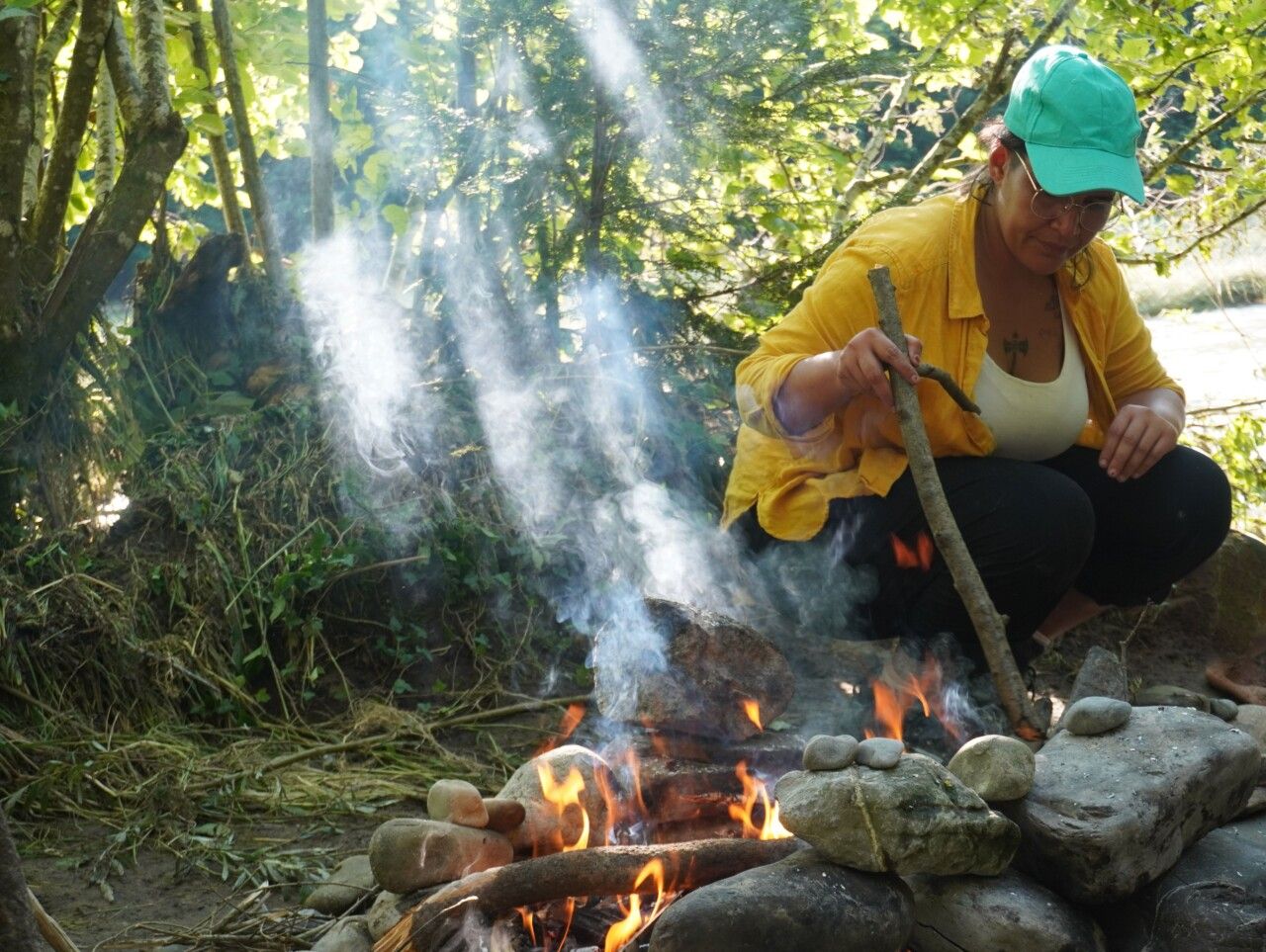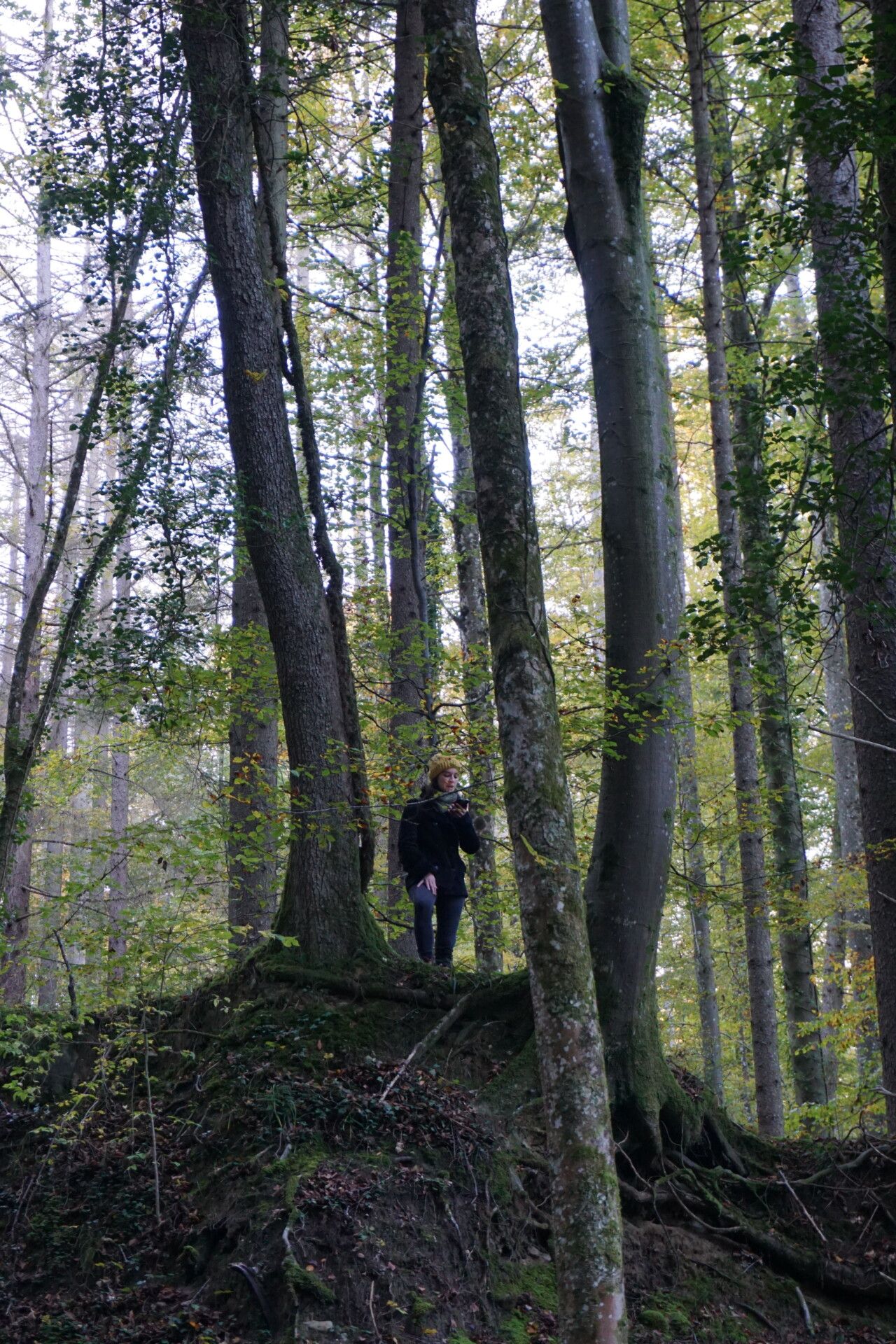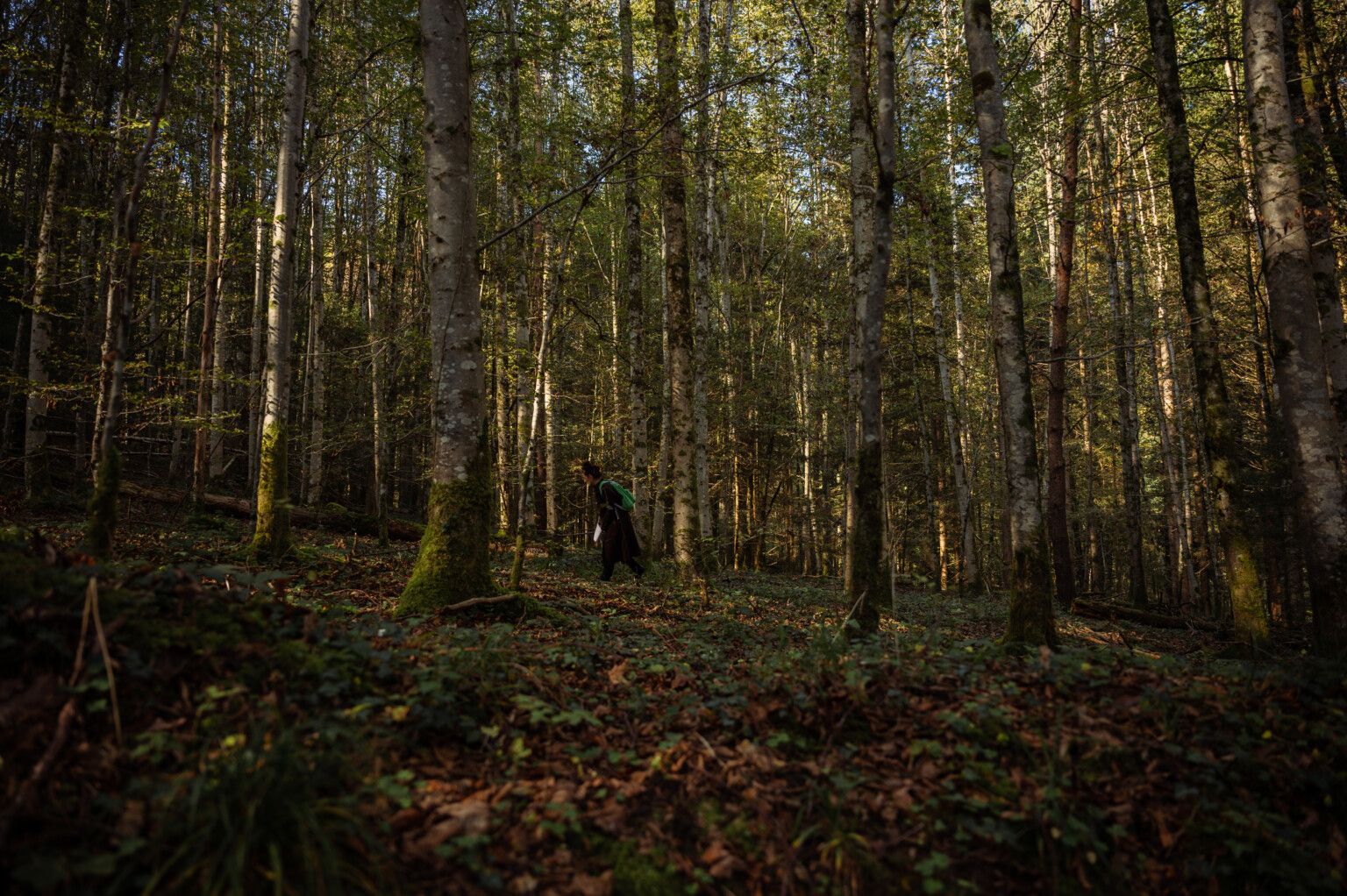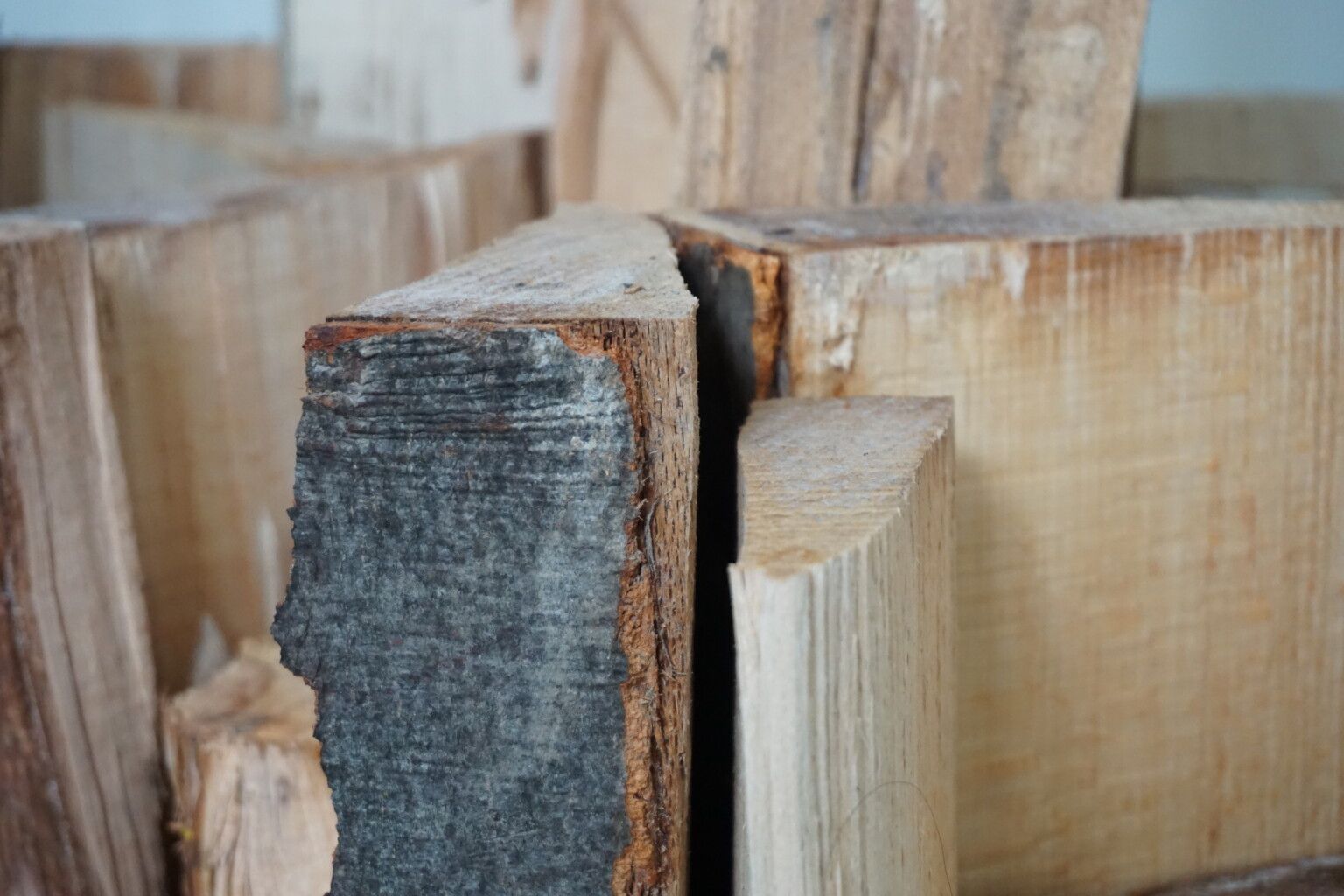Post-Walking Scriptum
We aim to learn from the forest, within the forest, with the forest, through the forest, in the forest, towards the forest… but as language already limits the range of our possibilities of learning, we needed to unlearn our own understanding of the forest, so we can extend our ideas and sensibilities towards the forest. Collaboratively, almost anonymously, we realized the plurality of the forest through a colourful path of collective writing. What is a forest, we asked and the forest transformed immediately into a forest of many worlds:
… a piece of land with a dense covering of trees, bushes, flora, fauna… usually large. I suppose a forest is larger than woods? A phenomenon in nature several million years old, which came about through the successful spread of trees on planet earth. Forests covered most parts of Europe and North America but the trees were unfortunately cut for use by the timber industry. Now replanting efforts are underway in many countries in order to reintroduce trees… complexity and biodiversity that should be more complex and more diverse, a victim of radical simplification, a magical entity. It is an ecosystem, lots of trees, lots of plants, lots of birds, lots of insects, bigger than my mind can comprehend. The forest floor is filled with mycelium pathways for carrying and communicating information. It has been brutally cut off in Baku and probably many large cities, yet is also something that I have a lot of access to living in Arnhem now.
I think this forest is like a space, a bracket, a ___________
ecology, collaboration and competition of different species
escape
collaboration of waters
place that feels secure but also unreachable
place I once was very familiar with and feels very strange now.
complex natural place
very complex biological system
connection to home
underground Network, covered by uncountable leaves
space for thought and clearing of the mind
space for curiosity
space I went hiding in my childhood dreams
place of/to escape
hill of ants.
home, a shelter, a world within a world.
living body.
The forest is lungs, a part of animal and human breathing systems, internet of mushrooms and trees, mythological location, death is transformed to new life. It is a breathing entity, an organism. The forest is a city, a system of checks and balances, far too complex to understand by a singular human mind. Its dominating population, trees, work with the other living organisms in their vicinity. A forest can be made, but better it is formed from seedlings into saplings and beyond. The most natural form of engagement where we can rest with freshness.
ecology / sanctuary / archive / library / medicine
The forest is a lot of big tall trees, the voices of birds, millions of invisible creatures, a space to contemplate cycles in nature and sometimes see beauty in death. The forest in question seems to be a very particular one that offers a sanctuary for many people, and also animals, lichen, mosses, fungi. Forests are an ambiguous place that can be scary at night when you're a child, or inconspicuous if you're not paying attention, but also a place of wonder, with lots hiding in plain sight.
Inhaling and exhaling
The forest is me, I am the forest…
At once, the question was: How do we inhabit the forest?
“The colonial mind thinks of walking as a way of discovering the world, walking as a way of conquering the world. But the world is there. We are just walking in order for the world to come toward us. Then you need to walk differently.” Trinh T. Minh-ha
… and we tried just that. We walked in the forest. Under the sun, a storm, and rain, we walked. On soil, mud, and trails, we walked. By river, streams, and puddles, we walked. With plants, animals, and insects, we walked (consciously or unconsciously). We walked for months in the Sihlwald, a forest between the Sihl river and the Albis hills, which for centuries was called the city forest, der Zürcher Stadtwald. The histories of the Sihl Forest are a complex entanglement of human and nonhuman cycles, materialities, and agencies. As we walked in the forest, we touched, played, and narrated with the multiplicity of beings; we enacted multiple relations, perspectives, and temporalities.
TECHNO FOREST FOOD was our first walk and we went outside of the marked forest paths to look into the history of the tree plantation and its socio-techno (dis-)entanglements and how they changed the ways of interacting with the forest.
The Sihlwald was conceived as a natural resource within a colonial structure. The city transformed the forest into their commodity, for which they created an "extractivist" infrastructure to support the timber exploitation. The city formed a trade monopoly where their officials and workers were in charge of cutting the wood, transporting it through the river to the city and selling it to the myriad artisans working in the city. This monopoly was reorganised during modern times. In the beginning, the transport was primarily realised through the Sihl river. To this end, a place in the city, Sihlhözli, was constructed to deliver the timber to the craftsmen. In the 19th century, the river lost relevance as a transport mechanism, and the first road from the forest to the outskirts of the city was constructed. Then around the end of the century, the city was already directly connected to the forest. Parallelly, the Sihltal railway line was built for timber transportation, and the forest had its own small railway system to facilitate the transport to the Sihltal railway line. Such extractivist practices have to be considered as the colonial past of the Sihlwald. Western modernity's colonial legacy is not only situated in former colonial territories or their internal societal structures. From the beginning, coloniality has included "nature" as another realm of subjugation, appropriation, and extraction.
We read out loud, made a fire and cooked collaboratively at the Sihl river to create new affective entanglements, until a storm drove us out of the forest.

(Photo: Virginia Kargachin)
#1 forest walk, Techno Forest Food, July 10th 2021
Which colours do you see in water?
What do you think is shaping the colours of water?
Take a sip from your drinking water and keep remembering
its colour while it runs through your body. Imagine it will change
colour as soon as it unfolds in your mouth, collaborates with
your bodily fluids and leaves your body. What colour do you see?
How does the colour of water change not only our perception
of water but also our mood, our approach, our love and fear towards
water?
What elements, memories and particles of you are affecting
the colours of water?
How would you describe the colours of water?
How can we think water neither green nor blue?
What if we could lose our common vocabulary to describe the
colours of waters?
Go to a riverbed, put your hand into the water, look at
your hand through the water, move your hand up and down
gently, touching the ground, swirl up the sediments, keep
looking at your hand, keep looking at the water – what colours
do you see?
How do our bodily fluids shape the colours of the waters?
Is the ocean’s colour just a reflection of the sky?
Look at the sky for a second; what colours do you see?
How is the light shaping the colours of water around us?
What is reflecting and what is coming from below?
Imagine any body of water - close to your hometown, or where
you grew up, or where you are living now - any water which is dear
to you. Imagine the water – what colour does it have?
Imagine submerging your head and opening your eyes underwater –
can you see, what colours do you see?
Sarina Scheidegger, Colores del Agua (2021)

In QUEER FOREST SPIRITS, our third walk, we disrupted the cultural normativity of the forest: we got lost away from the trails and, through deep listening and observing, we tried to create new connections and commitments in the material and spiritual realm of the forest.

Paula Baeza Pailamilla, Untitled (2021) (Photo: Jana Figliuolo)
And then we stopped, every (long) walk needs a stop to rest, to absorb and reflect the path we just walked; the exhibition A FOREST OF MANY WORLDS was such a pause where the collaborators had the opportunity to suggest positions, speculations, rhythms and perspectives to approach the forest
Dominik Zietlow, New trees until burned (2021) (Photo: Paula Baeza Pailamilla)
During the exhibition, we didn’t forget the Sihl Forest and we went back… During the performative walk FROM THE IN-BETWEEN, we hear the voices and traces of the stones, the river and the bark beetle.

You live beneath the surface, hidden from my eyes.
All I can see of you are your traces.
I know you from the news, from reports about mass death in the forests – caused by your
massive expansion.
Therefore, we call you a pest.
But you are actually much more than that.
In the forest, I notice your presence by the dead branches of the trees which you had once
inhabited. Your dwelling has caused their death since you and your children feed on the
vital tissue that supplies the tree’s bodies with water.
Although we, people from the West, believe in our control of what we call nature, in fact,
our human lives are intimately interwoven with all kinds of non-human life.
Your existence depends on the spruce tree, and we planted them en masse.
You are the parasite of our economical success.
You prosper thanks to global capitalism and climate change.
I think that the portrait of you as a parasite does not do you justice.
In fact, you are an actor yourself with an agency, and you actually act as a double agent:
you work on the destruction of the system that feeds you.
Willimann/Arai, The Gift Exercise / Invitation 6: Sihlwald (2021)
Lastly, we evoked the witches, creatures and spirits that have been habiting in the forest through stories and literature, only to wonder which stories would be told in the future.

Reading Walk, Devil’s Kitchen, October 23rd 2021.
Thus, we will keep walking.

Performative Walk, From the In-Between, October 17th 2021. (Photo: Jana Figliuolo)
How has the learning, working, and sharing environment of School of Commons helped in your discovery of perceiving and understanding the forest? Have the horizontal and shared working environments led to new, or more enriched questions for your research in learning with and from the forest, and can the different contexts and methodologies of School of Commons and School of the Forest crossover and merge?
School of Commons was the start of our walk. It was the moment and the space where we de-center our ideas of the forest. The pluriversality of the forest started through sharing, collaborating and caring. If we started with ten questions, then, we took hundreds with us. We never understood difference as a limitation - although, we would not say there were differences in contexts and methodologies. Actually, School of the Forest tried at all moments to reflect on the fundamental idea of commoning, maybe not always explicitly. School of the Forest would be always in-between, crossing and merging fluidly through differences and similarities.
Paula Baeza Pailamilla
Paula is a queer mapuche artist who works with performance, textile practices and audiovisual formats.
Jose Cáceres Mardones
Independent Curator.
Domenico Ermanno Roberti

